Interference
Interference of light is the phenomena of multiple light waves interacting with one another under certain circumstances, causing the combined amplitudes of the waves to either increase or decrease. In this piece, we discuss both the constructive and destructive interference of light waves, what causes interference, and some real-world examples and experiments that demonstrate this phenomenon.
What Is Light Wave Interference?
An important characteristic of light waves is their ability, under certain circumstances, to interfere with one another. The definition of interference in physics is the superposition of waves, causing an increase or decrease in the amplitude of the resulting wave. Most people observe some type of optical interference every day, but do not realize what is occurring to produce this phenomenon. One of the best examples of the interference of light is demonstrated by the light reflected from a film of oil floating on water. Another example is the soap bubble illustrated in Figure 1 that reflects a variety of beautiful colors when illuminated by natural or artificial light sources.
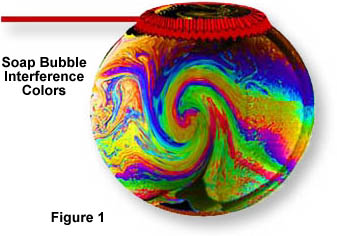
What Is the Difference Between Constructive and Destructive Interference?
This dynamic interplay of colors derives from the simultaneous reflection of light from both the inside and outside surfaces of the bubble (Figure 1). The two surfaces are very close together (the bubble is only a few microns thick), and light reflected from the inner surface interferes both constructively and destructively with light reflected from the outer surface. This is because light reflected from the inner surface of the bubble must travel further than light reflected from the outer surface. When the light waves reflected from the inner and outer surface combine, they will interfere with each other, removing or reinforcing some parts of white light by destructive or constructive interference. This results in the visible variations in color reflected from the bubble. If the extra distance traveled by the inner light waves is exactly the wavelength of the outer light waves, then they will recombine constructively, and bright colors of those wavelengths will be produced. In places where the waves are out of step, destructive interference will occur, canceling the reflected light (and the color).
How Does the Interference of Light Occur?
The following is an explanation of how light waves interfere with each other. Consider a pair of light waves from the same source that are traveling, for example, in direction D. This is the propagation direction (as illustrated in Figure 2), and if the vibrations (which are perpendicular to the propagation direction as represented by C in Figure 2) are parallel to each other and are also parallel with respect to the direction of vibration, then the light waves may interfere with each other. If the vibrations are not in the same plane and are vibrating at 90 degrees to each other, then they cannot interfere with one another.
Constructive Interference
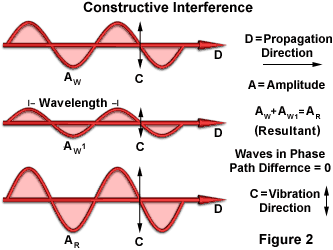
Assuming all of the criteria listed above are met, then the waves can interfere either constructively or destructively with each other. If the crests of one of the waves coincide with the crests of the other, the amplitudes are additive. If the amplitudes of both waves are equal, the resultant amplitude would be doubled. Bear in mind that light intensity varies directly as the square of the amplitude. Thus, if the amplitude is doubled, intensity is quadrupled. Such additive interference is called constructive interference (illustrated in Figure 2).
Destructive Interference
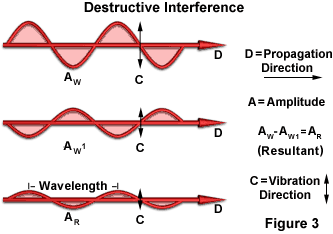
If the crests of one wave coincide with the troughs of the other wave, the resulting amplitude is decreased or may even be completely canceled, as illustrated in Figure 3. This is called destructive interference. The result is a drop in intensity, or in the case of total cancellation, blackness.
Interference of LightExplore how two light waves can combine to produce interference with one another.
Interference Examples
Thomas Young was an early 19th century physicist who demonstrated interference by showing that light is a wave phenomenon, and he also postulated that different colors of light were made from waves with different lengths. This was contrary to common opinion at the time, which was widely biased toward the theory that light is a stream of particles. In 1801, Young conducted an experiment providing important evidence that visible light has wave-like properties. This classic experiment, often termed "the Double-Slit experiment," originally used sunlight that had first been diffracted through a single slit as a light source. However, we will describe the experiment using coherent red laser light.
The Double Slit Experiment
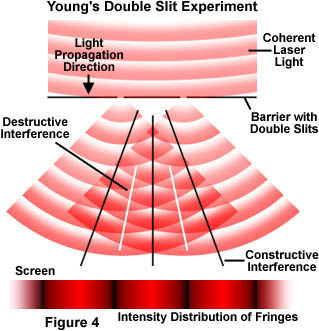
The basic setup of the double-slit experiment is illustrated in Figure 4. Coherent laser light is allowed to illuminate a barrier containing two pinhole apertures that allow only some of the light to pass through. A screen is placed in the region behind the slits, and a pattern of bright red and dark interference bands becomes visible on the screen. The key to this experiment is the mutual coherence between the light diffracted from the two slits at the barrier.
Young's Double Slit ExperimentDiscover how interference patterns change with wavelength and slit size.
What Are Interference Fringes?
As laser light is diffracted through the two barrier slits, each diffracted wave meets the other in a series of steps, as illustrated in Figure 4 (and graphically in the interactive tutorial described above). Sometimes the waves meet in step (or in phase; constructive interference), sometimes they meet out of step (or out of phase; destructive interference), and sometimes they meet partially in step. When the waves meet in step, they add together owing to constructive interference, and a bright area is displayed on the screen. In areas where the waves meet totally out of step, they will subtract from each other owning to destructive interference, and a dark area will appear in that portion of the screen. The resulting patterns on the screen, a product of interference between the two diffracted beams of laser light, are often referred to as interference fringes.
Other types of experiments have been devised to demonstrate the wave-like nature of light and interference effects. Most notable are the single mirror experiment of Humphrey Lloyd and the double mirror and biprism experiments devised by Augustin Fresnel. These experiments are described in detail in many of the physics books listed in our bibliography.
Newton’s Rings Experiment
Sir Isaac Newton, the famous 17th century mathematician and physicist, was one of the first scientists to study interference phenomena. In his famous Newton's Rings experiment, he placed a convex lens of large curvature radius on a flat glass plate and applied pressure to hold the lens and glass plate together. When he viewed the plates through reflected sunlight, he observed a series of concentric light and dark highly colored bands of light similar to those illustrated in Figure 5. Newton recognized that the rings indicated the presence of some degree of periodicity and used this observation to suggest a wave theory of light. Despite this, Newton regarded light as a stream of particles.
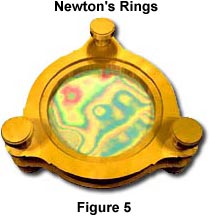
The rings occur because of a thin layer of air that exists between the curved convex and flat glass surfaces. Light reflected from the top and bottom surfaces of the glass is superimposed (combined) and produces interference patterns that appear as the colored rings. This principle is often used by lens manufacturers to test the uniformity of large polished surfaces.
Interference Intensity and Fringe Distribution
Interference intensity distribution fringes (such as those observed in Young's double slit experiment) vary in intensity when they are presented on a uniform background. The visibility (V) of the intensity was defined by Albert Michelson, an early 20th century physicist, as the difference between the maximum and minimum intensity of a fringe divided by their sum:
V = I(max) - I(min)/I(max) + I(min)
where I(max) is the maximum intensity and I(min) is the minimum intensity. From the equation, idealized fringe intensity always lies between zero and one, however in practice fringe visibility is dependent upon the geometrical design of the experiment and the spectral range used. This is responsible for the myriad of interference patterns observed in naturally occurring events.
Interference colors arising from stressed regions in materials can be easily observed in polarized light. The ruler in Figure 6 is made of plastic and is being observed through crossed polarizers. Under normal light, the ruler appears translucent with its graduations plainly visible. However, when viewed under polarized light, the ruler exhibits stress patterns that appear more profound in areas that are more highly deformed. This is due to a high degree of alignment of the long-chain polymer molecules that comprise the ruler. Note that the greatest degree of birefringence occurs near the hole on the left side of the ruler.

Real-World Uses of Interference
Other uses of the interference of light are measurements made over long distances with lasers. In this case, the lasers can be used to measure very small distances over a range of many miles. This is accomplished by splitting the laser beam and reflecting it back from different surfaces. Analysis of the resulting interference fringes (upon recombining the separate laser beams) will yield a remarkably accurate calculation of the distance between the two objects.
Holograms also depend upon the interference of light to produce their three-dimensional-like images. In reflection holograms, both a reference and object-illuminating beam are reflected onto a thick film from opposite sides. These beams interfere to produce light and dark areas that correspond to an image that appears three-dimensional. Transmission holograms use both the reference and object-illuminating beams on the same side of the film to produce a similar type of effect.
Interference also occurs with sound waves and waves induced in a standing pool of water. A very concise and easy interference experiment can be performed at home using a sink full of water and two marbles. First, let the water become very still, then simultaneously drop the marbles into the water (about 10-14 inches apart) from a height of about a foot. Just as with light waves, the two marbles will induce a series of waves in the water emanating in all directions. Waves formed in the area between where the marbles entered the water will eventually collide. Where they collide in step, they will constructively add together to make a bigger wave and where they collide out of step, they will destructively cancel each other out. Try it!
Sorry, this page is not
available in your country.



